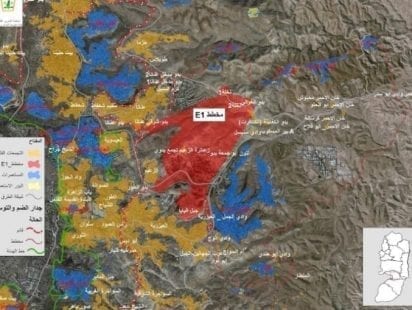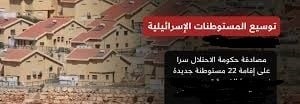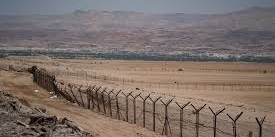By: Madeeha Al-A’raj
The National Bureau for Defending the Land and Resisting Settlements stated in its latest weekly report that , days before the scheduled date of the Civil Administration at the Israeli Occupation Army’s meeting scheduled this week regarding the very sensitive settlement plan in the E1 area in the occupied West Bank, which Israeli PM Netanyahu decided to postpone due to the international pressure, including the President Biden’s Administration, as construction in this area would completely separate north of the West from its center, and at the same time confirms that the so-called two-state solution is no longer on the agenda of the Palestinian-Israeli conflict.
This discussion takes place in light of the tensions between Washington and Tel Aviv after the later decision to allow settlers to transfer the religious school in Homesh to State lands in order to legitimize the outpost, contrary to what the Israeli Governments under Sharon and Netanyahu promised not to return to Homesh, and more recently, after the Knesset’s legislation that ‘the settlers will return to Homesh permanently.
The targeted area in the plan presented to the Civil Administration being responsible on that is about 12,000 dunams and is currently attached to the Municipality of the “Ma’ale Adumim” settlement. As for the construction plans there, they have been on the lists since the Rabin Government in the mid-nineties of the last century, but their implementation has been postponed since 2005 due to international pressure, only to return again in 2013, when a discussion took place in the Planning Council at the Civil Administration to promote construction plans in the area – at the initiative of Prime Minister Benjamin Netanyahu – and it was approved, which prompted the American and British Governments to protest by summoning the Israeli ambassadors in these countries, which prompted the Netanyahu’s Government at the time to postpone the implementation of the plan.
In 2017, the plan reared its head again, as another attempt was made to start construction in Area E1 through the Ma’ale Adumim’s Annexation Law, which intended to apply Israeli law to the aforementioned settlement, and E1, which was annexed to its lands. The law was supposed to be put to a vote in the Ministerial Committee for Legislative Affairs, and in 2020, Netanyahu announced that he had ordered the building plan to be promoted in that area again. It is the current plan that will be discussed in the Civil Administration next week, according to which 3,500 housing units will be built in that area.
As for the objections to the construction plan, which the Civil Administration will discuss, were submitted by the towns of Al-Eizariya, Anata, and Al-Isawiya, as well as the Associations of “Peace Now”, “Ir Amim” and “Environmental Justice”, given that the stealing of the area and planting it with this large number of housing units will damage the only remaining land reserves in the heart of cities of Ramallah-Jerusalem-Bethlehem cites, where about a million Palestinians live, and it will have clear consequences for the Bedouin Communities in the area, which are more than 30, such as Al-Khan Al-Ahmar and other Bedouin communities extending to the Dead Sea.
Commenting on the stance of the Civil Administration, and its start to discuss objections to the construction plan in the E1 area, the Israeli Peace Now Movement said that this falls within the framework of appeasing Smotrich’s friends, and that it then deals a blow to the American friends, and most importantly, that the annexation government in the words of the movement continues work according to a systematic plan that will drag us into the reality of apartheid.”
On the other hand, the Israeli Minister of National Security, Ben Gvir, announced his intention to increase the number of those who are allowed to obtain a license to carry weapons, within the framework of updating the conditions for obtaining a firearm license, and accordingly, every former soldier with a ‘combatant’ card, as well as soldiers who served in the army for a short period in parallel with their studies in Torah teaching institutes scattered in the settlements inhabited by extremists, and every volunteer in the Israeli aid organization ‘Maen David Adom’ from obtaining a weapon license without undergoing the necessary examination, which means an increase in the number of people carrying weapons by tens of thousands, noting that settlers are at the top of the list of licensed weapon holders.
It was found that 86 out of the 100 towns in which the percentage of weapon bearers is high are settlements in the West Bank, and the “Adora” settlements in the south of the Hebron Hills, “Kiryat Netafim” and “Neghot” are the places where the highest percentage of gunmen are located, showing those who carry arms are a third of its population. The “Ariel” settlement also tops the list, with a percentage of 9.2% carrying weapons, and “Ma’ale Adumim” settlement, where the percentage is 6%.
List of Israeli Assaults over the Last Week Documented by the National Bureau:
Jerusalem:
- Forcing 5 Jerusalemite families to demolish 2 buildings consisting of 5 housing units in the Wadi Qaddum Neighborhood in the town of Silwan, otherwise they pay a heavy amounted to NIS 200,000, claiming that they don’t have building permits.
- Uprooting 50 olive trees in the Tablas area, in the town of Hizma, and demolished a retaining wall surrounding 4 dunums in the same area, as well as bulldozing several agricultural roads.
- Attacking residents of the Sheikh Jarrah Neighborhood with bullets, stones, and pepper gas.
Hebron:
- Storming the ‘Tal Ma’in’ site south of Hebron, performed Talmudic rituals in it,
- Preventing shepherds from grazing their sheeps in the Al-Thala area near the Yatta town, destroyed their summer crops, and seized a water well, in Masafer Yatta.
Bethlehem:
- Notifying Moh’d Ibrahim Da’udu of demolishing his house located in the Um Rukba area, in the town of Al-Khader, south of Bethlehem, in which 9 people live..
Ramallah:
- Attacking citizens’ vehicles between the town of Turmusaya and the village of Al-Mughayer.
- Cutting down fruit trees and destroyed irrigation lines for farmers in the Ein Samia ara to evacuate the gathering.
- Demolishing a house located in the ‘Ain Harasha area’ in the western town of Al-Mazra’, located in areas C.
- Razing 25 dunums of land in the Maghrabat area adjacent to the town of Sinjil, began excavation work on the land, for the benefit of the “Givat Haru’eh” outpost, which is located there in order to expand it, which is among the 9 outposts recently legalized by the occupation authorities,
- Attacking the village of Al-Mazra’a Al-Gharbiyya, assaulted citizens and set fire to its land in the Harasha area, west of the village.
Nablus:
- A group of settlers infiltrated from the evacuated ‘Homesh settlement’ protected by the occupation forces, and attacked citizens’ homes in several areas in the Burqa village, which resulted in the injury of 4 citizens with shrapnel live bullets, and another with bruises, as well as 55 suffocated with tear gas. Attacking 3 houses on the outskirts of the village with stones.
- Smashing windows of a number of vehicles on the Jenin-Nablus road, and 2 houses were evacuated due to the intensity of the toxic gas.
Jenin:
- Touring lands of the evacuated ‘Tirsala Sanur’ settlement near the towns of Jaba’, Ajja and Sanur, by occupation soldiers, which is close to the site where they rebuild the ‘Homesh’ settlement. Israeli activities, and military patrols were seen storming it during daylight hours, to allow settlers return to these areas.
- Erecting a roadblock to the southwest of Jenin in protest against its eviction scores of settlers from ‘Harmish’ settlers by the army, and blocked the road through which Palestinian vehicles pass near the settlement.
 المكتب الوطني للدفاع عن الارض ومقاومة الاستيطان منظمة التحرير الفلسطينية
المكتب الوطني للدفاع عن الارض ومقاومة الاستيطان منظمة التحرير الفلسطينية




